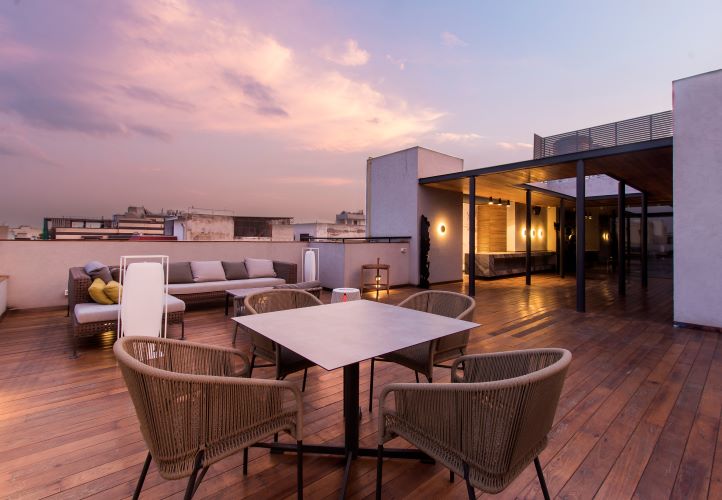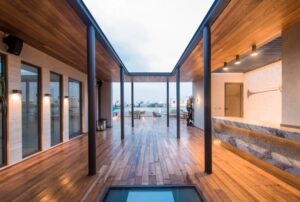DESIGNING STYLISH OUTDOOR SPACES

Natasha N Kochhar
The desire to connect with nature is a powerful human drive. We crave spaces to escape the confines of our homes and immerse ourselves in the vibrant tapestry of the outdoors. This yearning for fresh air, natural light, and a connection to the surrounding environment is particularly relevant in our modern world, where the allure of technology and urban life often dominates. Fortunately, we can cultivate a personal sanctuary within our own homes, a space where the boundaries between indoors and outdoors seamlessly blur. This is where the art of designing functional and stylish outdoor living spaces comes into play. Here, we share some creative strategies to transform your outdoor space into a haven of both functionality and style.
Define Zones and Create “Outdoor Rooms”
Move beyond the singular concept of a patio or deck. Instead, approach your outdoor space as an opportunity to create distinct “rooms” dedicated to specific activities. This could involve a designated dining area with a weatherproof table and comfortable seating, a relaxation zone with plush lounge chairs and a fire pit, a dedicated cooking station, or even an outdoor kitchen. Defining zones through subtle changes in flooring materials, strategically placed planters, or variations in lighting allows for a more intentional and functional use of the space. Consider incorporating ambient lighting such as string lights or lanterns, creating a cosy atmosphere for evening gatherings. Weather-resistant rugs or outdoor carpets can aid in defining the seating and lounge areas, providing both visual appeal and a comfortable underfoot surface. Further, integrating shade elements like pergolas or umbrellas can offer relief from the sun, making each outdoor room more inviting throughout the day.
Blur the Lines Between Indoors and Outdoors
Embrace the concept of “indoor-outdoor living” by creating a seamless connection between your interior and exterior spaces. Large sliding glass doors, strategically placed windows, and the use of similar materials like natural stone or wood flooring for both indoor and outdoor areas can achieve this visual continuity. Coordinating furniture cushions, throw pillows, and decor elements with the indoor theme can create a cohesive look. This not only fosters a sense of spaciousness but also allows for natural light and ventilation to flow freely, enhancing the overall feeling of connection to nature. Further, installing retractable screens or curtains can offer flexibility in controlling privacy and shade, providing an adaptable environment that suits various weather conditions and preferences.
Embrace the Power of Multifunctional Furniture
Outdoor furniture plays a crucial role in defining the aesthetics and functionality of your space. Opt for pieces that are not only stylish but also serve multiple purposes. Consider nesting tables that can be easily expanded or contracted depending on the occasion, chairs with built-in storage compartments, or ottomans that can double as coffee tables. These flexible configurations can be rearranged to accommodate different group sizes or activities, making your outdoor space truly adaptable. Furthermore, invest in durable, all-weather materials for furniture to withstand the elements and ensure long-lasting functionality and style. This smart approach to furniture selection maximises space utilisation and ensures your outdoor living area remains clutter-free and adaptable to different needs.
Nature as a Design Element
Don’t underestimate the power of landscaping in crafting a functional and aesthetically pleasing outdoor space. Utilise plants strategically to create privacy screens, define boundaries between zones, or add pops of colour and texture. Consider incorporating native and low-maintenance plants that thrive in your climate, reducing the need for excessive watering and maintenance. consider introducing natural materials like bamboo or sustainable wood for outdoor structures, contributing to an eco-friendly and harmonious design that resonates with the surrounding environment. Incorporating natural materials like stone, wood, and water features can further connect your outdoor space to the surrounding landscape, promoting a sense of harmony and tranquility.
Remember, the true beauty of an outdoor living space lies not just in its aesthetics, but in its ability to connect you to the natural world and enrich your overall well-being. So, embrace the possibilities, let creativity guide your decisions, and step outside to begin crafting your oasis.
Architect Natasha N Kochhar is Associate Partner and Strategist
at LTDF Architecture + Interior Design


